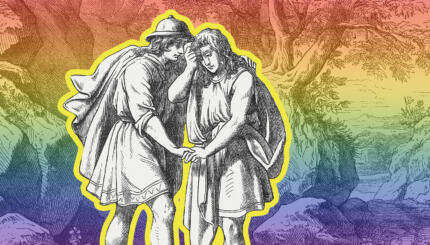Part Two of a two-part story of a gay rabbinical student in the Reform Movement. Yesterday Ari shared his place in the history of openly gay rabbinical students. Today Ari delves deeper into navigating his identities. You can also hear from Rabbi Elianna Yolkut on her journey from the closet to the pulpit on Rabbis Without Borders.
In 2008, I made the decision to enter rabbinical school as an openly gay man. The decision was in some ways very easy and in some ways very difficult. My concerns centered on one main question: what would my gay and Jewish community be like? After my initial year at Hebrew Union College (HUC) in Israel, I received some less than ideal news: my new home would be at the HUC campus in…Cincinnati.
This had not been my initial choice and I was none too pleased, having been born and raised in New York. But, I thought, “I am sure that I will not only be welcomed with open arms, but I will find a loving community who can help model for me being a gay rabbinical student, and subsequently a gay rabbi…right?”
I soon discovered, at least for my first year, I was the only openly gay student on campus; my therapist always tells me that it’s important to note openly gay, because you never know, and I do appreciate her optimism. Somehow by default, I became a halutz (a pioneer), the very identity I had hoped to avoid when I chose to be a gay rabbinical student in the Reform world, as opposed to the Conservative one.
In Cincinnati, I had to actively think about how to navigate all of my identities with a limited support network. In a conservative Midwestern city, I found myself working with even smaller–and sometimes even more conservative–congregations as their student rabbi. How would I come out to my student pulpits? Should I use them as bully pulpits to advocate for the causes that I find important and meaningful? How do I seek out a solid LGBT Jewish community outside of the school, when school takes up most of my life? And of course the biggest question: am I a gay rabbi, or am I a rabbi who is gay?
These two sentences may sound alike, but they could not be more different, as I discovered a few months ago in trying to craft a personal statement to send out to congregations to apply for possible rabbinic positions. In my personal statement, I told a story of building a relationship with a congregant in a community in Northwest Florida who was initially hesitant about having an openly gay rabbinical student; the fact that I had not yet mentioned my sexuality to that community, but rather had been outed by my predecessor is a whole other story. I wrote that over the two years I served there, we grew to form an incredible relationship, and that I hoped to have shifted his perspective if only a small amount.
The story I told for my personal statement was met with a resounding and near universal opposition. I was told that it foregrounded my sexuality too much: It showed me as “the gay rabbi” more than “Ari who is gay”…and also holds many other identities and traits, of equal value and import. While this is certainly true, it felt strange to hear from – mostly straight – friends, colleagues, and teachers that it would behoove me to “tamp down the gay.” In a recent article in Slate.com, gay writer J. Bryan Lowder lamented how some public figures have taken to coming out by stating that being gay is only but one small part of who they are, not their whole essence. Lowder believes, as do I, that this emphasis diminishes the value of coming out and acting as a role model to fellow LGBT people.
As I round the bases towards my eventual finishing of this program, I have no more answers to that quandary than I did when I started. I think sometimes you just have to be a halutz, taking the lonely road for the sake of those who will one day follow. It can be challenging, but at least it creates some pretty great stories.
The Jewish world is full of debates. Get the latest in MyJewishLearning’s weekly blogs newsletter.

